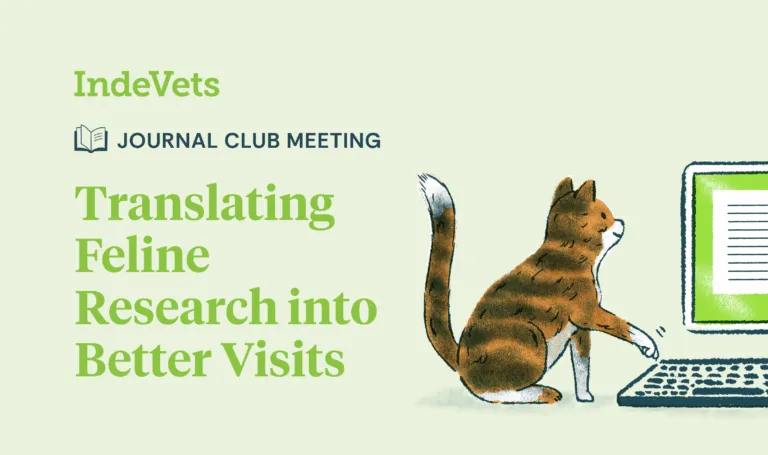Feline Research in Action at IndeVets


How IndeVets Is Translating Feline Research into Better Visits
At IndeVets, staying current with medical research isn’t a solitary activity – it’s a conversation. Our latest Journal Club brought together practicing veterinarians from across the country to dive deep into two recent feline studies with one shared goal: to incorporate our shared clinical experience into a collaborative discussion about recent veterinary literature to ensure that we are all providing the most up to date care to our patients.
Easing the Feline Fear Factor: Trazodone and Vet Visit Anxiety
We kicked things off with a discussion of the JAVMA study, “Efficacy of a single dose of trazodone hydrochloride given to cats prior to veterinary visits to reduce signs of transport- and examination-related anxiety.” The randomized, double-blind crossover study followed 10 cats with known travel and exam stress and compared their behavior after receiving either trazodone or a placebo before their vet visit.
The results? Across the board, trazodone significantly reduced signs of anxiety prior to, during, and after the veterinary encounter.
Owners and veterinarians reported improved tractability, reduced vocalization, and lower stress scores before, during, and after the visit. Even more notably, trazodone didn’t affect vital signs, and adverse events were minimal – mostly mild sleepiness or third eyelid elevation.
Key Takeaway: Trazodone offers a promising alternative to gabapentin for pre-visit pharmaceuticals (PVPs) – especially for cats who don’t respond well to gabapentin or where pill format is easier for owners. But, as our attendees wisely pointed out, this was a small sample size. We’re eager to see larger studies, head-to-head comparisons with gabapentin, and exploration of combination protocols.
Clinical Pearl: The use of trazodone at 50 mg PO administered 1-1.5 hours prior to transport significantly reduced feline anxiety associated with veterinary visits, with owners successfully administering it via treats, canned food, or directly by hand.
Tightening Up Dental Healing: The Case for Buried Knots
Next, we looked at a practical surgical study from the Journal of Feline Medicine and Surgery titled “Effect of a buried knot in the healing process of dental extraction sites: a prospective study in cats.” This split-mouth, randomized trial involving 40 cats compared standard simple interrupted sutures to the same technique using buried knots.
The buried-knot technique showed significant improvements at 2- and 4-week post-op check-ins in key indicators:
- Less swelling, bleeding, and redness
- Reduced ulceration and food debris accumulation
- Improved comfort on palpation
No complications were observed in either group by 6 weeks, but the early healing benefits clearly favored the buried-knot technique.
Key Takeaway: If you’re already using monofilament absorbable sutures, adopting the buried-knot approach may reduce inflammation and improve short-term comfort—especially important in cats with chronic oral inflammation.
Clinical Pearl: Burying the knot prevents it from acting as a nidus for debris and trauma, reducing early post-op complications, improving patient comfort and mitigating owner-reported concerns.
A Culture of Collaborative Growth
What makes these discussions unique to IndeVets isn’t just the journal articles, it’s how we use them. Our Journal Club isn’t a lecture, it’s a conversation among peers who share tips, personal experiences, ask critical questions, and turn data into clinically supported decisions.
Here’s what makes our approach different:
- Everyday relevance: We ask, “How does this apply in my practice this week?”
- Nuanced critique: We discuss limitations, like sample size and dosing protocols.
- Shared expertise: From feline-only practice veterans to surgery-shy generalists, everyone brings value.
- Actionable outcomes: These aren’t just academic exercises—they shape our clinical decisions.
I really enjoy being a part of Journal Club, something I've never experienced before joining IndeVets. Because life is busy, I don't get a chance to review journals like I wish I could, and Journal Club hits the highlights of current articles with practical application for everyday practice. The smaller group also feels less intimidating and more collegial. - Lori Seelhoff, DVM & Associate IndeVet
What’s Next?
Our team expressed strong interest in further exploring the clinically relevant pieces of veterinary literature that will help them shape their style of practice to remain aligned with this ever-changing field. Stay tuned for more insights from our Journal Club meetings.
Want to Join the Conversation?
Whether you’re an IndeVet or a vet from outside our organization, we’d love to hear how you’re integrating new research into your practice. Share your insights, questions, or feline dentistry tricks with us on social media or via our upcoming virtual discussion forums.
Are you an IndeVet interested in attending the next Journal Club? Reach out to Casey Robinson or Michelle Trewartha to get involved.
